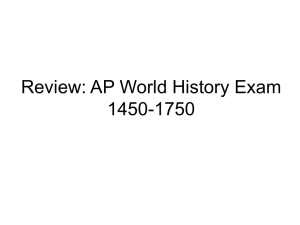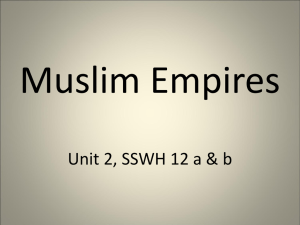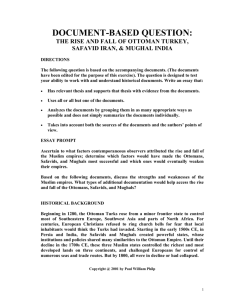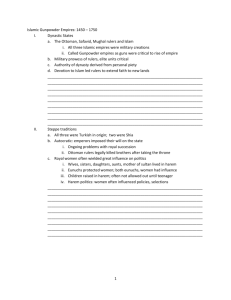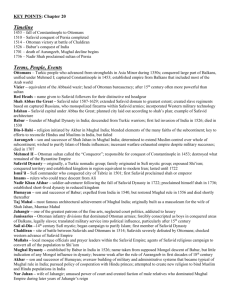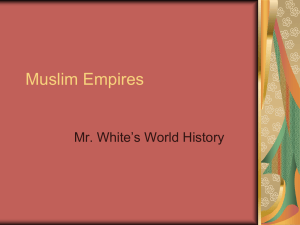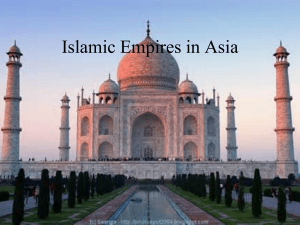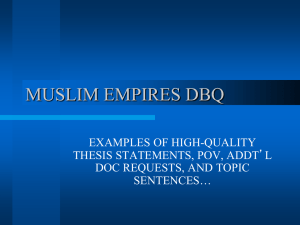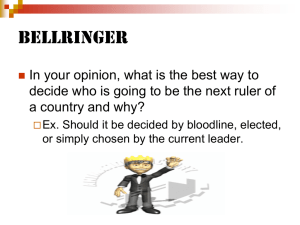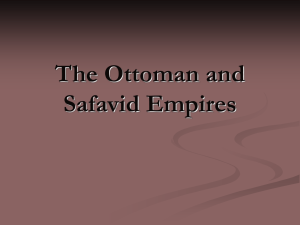WHAP EXAM REVIEW TEST #4: Early Modern Period Which
advertisement
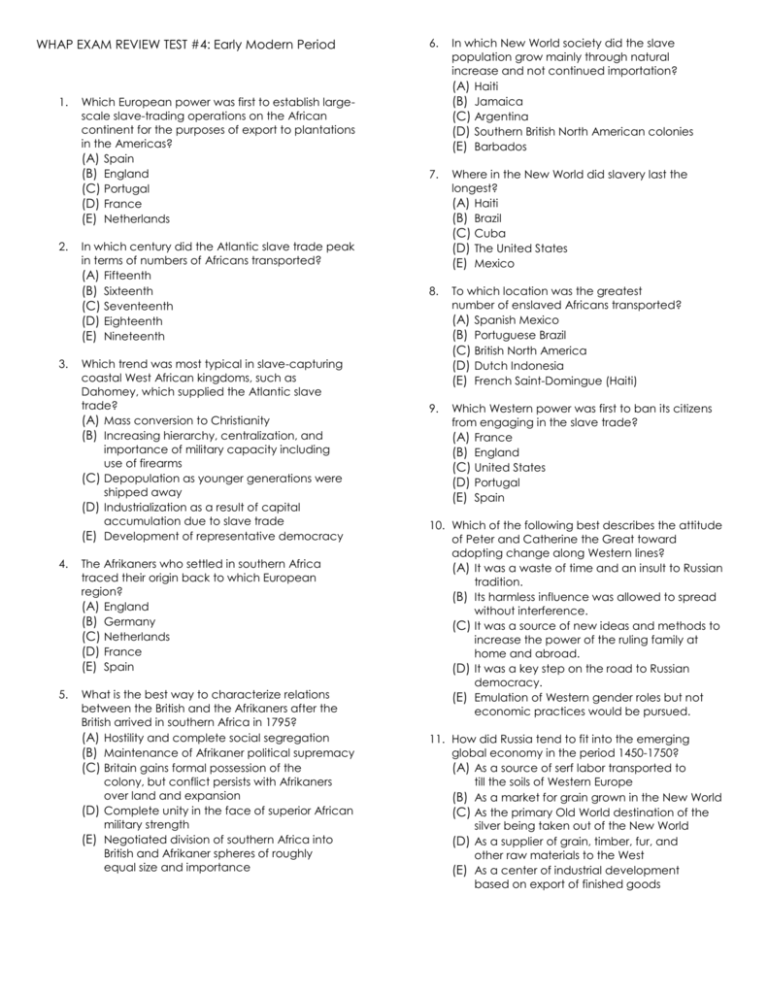
WHAP EXAM REVIEW TEST #4: Early Modern Period 1. 2. 3. Which European power was first to establish largescale slave-trading operations on the African continent for the purposes of export to plantations in the Americas? (A) Spain (B) England (C) Portugal (D) France (E) Netherlands In which century did the Atlantic slave trade peak in terms of numbers of Africans transported? (A) Fifteenth (B) Sixteenth (C) Seventeenth (D) Eighteenth (E) Nineteenth Which trend was most typical in slave-capturing coastal West African kingdoms, such as Dahomey, which supplied the Atlantic slave trade? (A) Mass conversion to Christianity (B) Increasing hierarchy, centralization, and importance of military capacity including use of firearms (C) Depopulation as younger generations were shipped away (D) Industrialization as a result of capital accumulation due to slave trade (E) Development of representative democracy 4. The Afrikaners who settled in southern Africa traced their origin back to which European region? (A) England (B) Germany (C) Netherlands (D) France (E) Spain 5. What is the best way to characterize relations between the British and the Afrikaners after the British arrived in southern Africa in 1795? (A) Hostility and complete social segregation (B) Maintenance of Afrikaner political supremacy (C) Britain gains formal possession of the colony, but conflict persists with Afrikaners over land and expansion (D) Complete unity in the face of superior African military strength (E) Negotiated division of southern Africa into British and Afrikaner spheres of roughly equal size and importance 6. In which New World society did the slave population grow mainly through natural increase and not continued importation? (A) Haiti (B) Jamaica (C) Argentina (D) Southern British North American colonies (E) Barbados 7. Where in the New World did slavery last the longest? (A) Haiti (B) Brazil (C) Cuba (D) The United States (E) Mexico 8. To which location was the greatest number of enslaved Africans transported? (A) Spanish Mexico (B) Portuguese Brazil (C) British North America (D) Dutch Indonesia (E) French Saint-Domingue (Haiti) 9. Which Western power was first to ban its citizens from engaging in the slave trade? (A) France (B) England (C) United States (D) Portugal (E) Spain 10. Which of the following best describes the attitude of Peter and Catherine the Great toward adopting change along Western lines? (A) It was a waste of time and an insult to Russian tradition. (B) Its harmless influence was allowed to spread without interference. (C) It was a source of new ideas and methods to increase the power of the ruling family at home and abroad. (D) It was a key step on the road to Russian democracy. (E) Emulation of Western gender roles but not economic practices would be pursued. 11. How did Russia tend to fit into the emerging global economy in the period 1450-1750? (A) As a source of serf labor transported to till the soils of Western Europe (B) As a market for grain grown in the New World (C) As the primary Old World destination of the silver being taken out of the New World (D) As a supplier of grain, timber, fur, and other raw materials to the West (E) As a center of industrial development based on export of finished goods 12. Which feature of the expanding Russian Empire in the period 1500-1800 was NOT a feature of expanding Western European empires in this period? (A) Military dominance over less technologically sophisticated peoples. (B) Multiple ethnicities fell under the rule of a single monarch. (C) Territorial expansion was a major goal. (D) Natural resources and agricultural products were extracted from the newly absorbed lands. (E) Expansion was mainly carried out over land and not sea. 13. Which end result of industrial development was most important to Peter the Great? (A) Russian capacity to produce modern weapons (B) Growth of a vibrant merchant class (C) A raised cultural level of the resultant urban masses (D) Ability to project naval power across the Pacific Ocean (E) More ideal conditions for the growth of the Bolshevik party 14. Which impulse for the colonization of North America was generally missing from the colonization of the rest of the New World? (A) Setting up slave plantations (B) The search for gold (C) Freedom from religious persecution (D) Expansion of royal authority (E) Missionary drive to convert Native Americans to Christianity 15. How was racial hierarchy on the North American continent different from racial hierarchy in Spanish Latin America? (A) Intermarriage among Native American, African, and European populations was much less common. (B) Enslaved Africans could as a rule look forward to manumission upon the death of his or her owner. (C) Native Americans were preferred over Africans to perform slave labor. (D) European settlers formed a smaller minority of the overall population. (E) Native American leaders enjoyed equal political and social status as European elites in colonial society. 16. In which colonized region of the globe did Western cultural practices supplant existing cultural practices most completely after 1450? (A) West Africa (B) North and South America (C) East Asia (D) South Asia (E) South Africa 17. In which way did the Spanish colonies reproduce existing Iberian social structures? (A) Colonies were established as monarchies in their own right. (B) Gender roles were preserved from the very start as equal proportions of Spanish males and females settled the New World. (C) Peninsulares sought to reproduce essentially feudal estates with indigenous labor filling the role of the Spanish serf. (D) Religious toleration remained an important factor in integrating diverse peoples into a cohesive social unit. (E) Extended families continued to live in clan compounds headed by matriarchal authority figures. 18. Which region of the New World saw the initial penetration by European explorers and subjugation of the Native population to slave labor? (A) Mesoamerica (B) Andean South America (C) Caribbean Islands (D) Atlantic shoreline of North America (E) Atlantic shoreline of South America 19. Which of the following accompanied the transition from conquest to settlement of the New World? (A) Transition from the search for gold to setting up of ranches and sugar plantations (B) Increased emigration of Spanish women to the New World (C) Disappearance of the majority of the indigenous population through disease or killing (D) Importation of African slaves to work plantations (E) All of the above 20. Which New World commodity was of the greatest value to the Spanish monarchy? (A) Potato (B) Tomato (C) Silver (D) Sugar (E) Quinine 21. Which New World commodity was of the greatest value to the Portuguese monarchy in the early phases of the settlement of Brazil? (A) Potato (B) Tomato (C) Silver (D) Sugar (E) Quinine 22. Which statement best characterizes the political situation in the West around 1450? (A) Highly centralized and powerful monarchies governed linguistically homogeneous kingdoms. (B) Renaissance ideas had spread, making democracy the preferred political system. (C) Small political units led by local and regional aristocrats were the rule, not the exception. (D) The nation-state had taken root and monarchy had passed from the scene. (E) The Holy Roman Empire had united the West into a larger political unit than the Roman Empire of the classical era. 23. Why did the Renaissance originate in the citystates of northern Italy? (A) Urban artisans provided financial backing. (B) Expatriate Chinese artists settled there, provided artistic training. (C) Urban elites grown rich in trade hubs provided financial backing. (D) The bubonic plague depopulated the countryside more heavily, destroying rural centers of artistic innovation. (E) Techniques left behind after Ottoman occupation formed the basis for new explorations in art. 24. Which event is most closely associated with the "reintroduction" of the West to the knowledge and trade of the Middle and Far East after the year 1000? (A) The voyages of Vasco da Gama (B) The Black Death (C) The travels of Ibn Battuta (D) The Crusades (E) The travels of Marco Polo 25. Which group traces its roots to the Catholic Reformation, sometimes referred to as the Counter-Reformation? (A) Benedictine monks (B) Coptic Christians (C) Jesuits (D) Liberation theologians (E) Calvinists 26. Which movement from the following list established a tradition of seeking answers to questions about nature through the application of reason and methodical investigation of the world? (A) Phenomenology (B) Scientific Revolution (C) Protestant Reformation (D) Enlightenment (E) Renaissance 27. Which of the following movements applied reason to the problems of human affairs and can be understood as an extension of the Scientific Revolution into the field of politics? (A) Renaissance (B) Green Revolution (C) Enlightenment (D) Protestant Reformation (E) Bolshevik Revolution 28. Compared, broadly speaking, with other centers of civilization in the world, which of the following had become the most distinctive characteristic of Western intellectual life by about 1750? (A) Concern with manipulation of nature to serve human interests (B) Centrality of science in understanding reality (C) Appreciation of poetry in elite circles (D) Importance of the written word in preservation of the wisdom of the past (E) Innovation resulting from exposure to the knowledge and practices of other civilizations 29. Which group suffered the greatest loss of authority as absolute monarchy took hold in the West beginning in the seventeenth century? (A) Monarchs (B) Merchants (C) Peasants (D) Aristocrats (E) Artisans 30. Which of the following kingdoms serves as an exception to the rule of the growing power of absolute monarchies in the West in the period 1450-1750? (A) Spain (B) France (C) Austria-Hungary (D) Prussia (E) England 31. The relationship between supply and demand, as well as the concepts of "laissez-faire" and the "invisible hand of the market," can be traced to the writings of (A) Karl Marx (B) David Ricardo (C) Adam Smith (D) Napoleon Bonaparte (E) Giovanni Boccaccio 32. Which of the following does NOT belong in a list of principles we can identify with the intellectual movement known as the Enlightenment? (A) Reason is the way to truth. (B) Rulers are blessed by the divine. (C) Humans are naturally good. (D) Blind faith in religion is wrong. (E) People have rights. 33. Which of the following effects best captures the impact of the Mongol Empire on world history? I. Spread of the bubonic plague across the Eurasian landmass II. Stabilization of long-distance trade routes, which sparked greater demand for goods from distant lands III. The exposure of old centers of civilization to new religious and intellectual trends (A) I and II (B) II and III (C) I and III (D) I, II, and III (E) II only 34. Which statement best characterizes power relations among the centers of Eurasian civilizations as they approached the year 1450? (A) Islamic caliphates are reaching the height of their power and influence. (B) Ming rulers of China have redoubled their efforts to move to the center of maritime trading networks in the East Asian and Indian Ocean. (C) A power vacuum of sorts has opened, as Byzantine, Abbasid, and Ming Chinese powers become less of a force in global affairs. (D) Western Europe dominates world trade. (E) South and East Asia are no longer important sources of luxury items in long-distance trade networks and become increasingly isolated. 35. How do historians explain the Ming dynasty's 1433 decision to abandon the treasure ship voyages to the Indian Ocean basin that could have placed China at the core of the developing world economy? (A) State resources were required to thwart nomadic incursions from beyond the Great Wall. (B) A dominant neo-Confucian worldview deemphasized the value of non-Chinese ideas and products. (C) State-backed exploration of distant lands was an unusual experiment in Chinese history. (D) Internal economic development was flourishing, making long-distance trade unnecessary. (E) All of the above 36. Which of the following can be characterized as outside the world network of trade in 1450? (A) Ireland (B) Scandinavia (C) East Africa (D) Mesoamerica (E) The Philippines 37. We associate the Maori people with which of the following locations? (A) Tasmania (B) Azores (C) New Zealand (D) Hawaii (E) Polynesia 38. Which of the following established a line of demarcation separating Spanish and Portuguese claims in the New World? (A) Treaty of Versailles (B) Edict of Nantes (C) Treaty of Westphalia (D) Treaty of Tordesillas (E) Luther's 95 Theses 39. Which European power won the colony of Indonesia away from the Portuguese in the seventeenth century? (A) England (B) Spain (C) France (D) Holland (E) Italy 40. Which colony was claimed by Spain as a result of Ferdinand Magellan's circumnavigation of the globe in 1519-1521? (A) Madagascar (B) Hispanola (C) Mexico (D) The Philippines (E) Canary Islands 41. What was the demographic impact of the Columbian Exchange on the populations of the Old World? (A) Population growth across the Old World based on New World crops such as corn and the potato (B) Massive depopulation of Western Europe due to migration to the Americas (C) Sharp increase in the West African population to furnish individuals for the slave trade (D) Sharp decrease in male populations as many sailors died at sea (E) Greatly increased life expectancy aided by new medicinal plants from New World tropical rainforests 42. In which regional waterways did the West most rapidly emerge into a dominant position after 1450? (A) Eastern Mediterranean (B) South China Sea (C) Arabian Sea (D) Caribbean Sea (E) Yellow Sea 43. Which of the following regional civilizations was least able to control and regulate its trade relations with the West in the period 1450-1750? (A) Safavid Persia (B) Tokugawa Japan (C) Kongo kingdom (D) Ming China (E) Mughal India 44. Which was the first Asian commodity Western merchants were able to gain control over in terms of both production and trade? (A) Cotton (B) Opium (C) Spices (D) Porcelain (E) Silk 45. The rule of which Chinese dynasties overlap with the time period 1450-1750? I. Yuan II. Ming III. Qing IV. Song (A) I and IIIII (B) and IV (C) I and IV (D) II and III (E) III and IV 46. Which three Muslim empires emerged from the wreckage left behind after the Mongol invasions? (A) Umayyad, Safavid, Mughal (B) Mughal, Safavid, Ottoman (C) Abbasid, Ottoman, Umayyad (D) Mughal, Umayyad, Abbasid (E) Ottoman, Umayyad, Safavid 47. Which is the most distinguishing characteristic of the Safavid civilization when compared to its Ottoman and Mughal empires? (A) High levels of palace intrigue and violent fights for succession to the throne (B) Limited public roles for women (C) Adherence to Shia and not Sunni Islam (D) Growing interaction with maritime Western powers (E) Architectural and artistic splendor 48. Which of the following does NOT belong in a list of regions under Ottoman control at the height of their rule in terms of territory gained? (A) North Africa (B) Middle East (C) Anatolia (D) Spain (E) Balkan peninsula 49. Religious tolerance, Hindu-Muslim intermarriage, and abolition of the jizya head tax are all most closely associated with which Mughal ruler? (A) Selim II (B) Akbar (C) Babur (D) Aurangzeb (E) Shah Jahan 50. Which destabilizing influence did the Ottoman, Mughal, and Safavid empires face in the period 1450-1750? (A) A growing influx of silver through trade with the West leading to widespread inflation (B) Revived threats from central Asian nomads (C) Western siege and occupation of their capital cities (D) Unprecedented drought (E) Bubonic plague outbreaks that reduced populations by one-third 51. Which development in a contemporary civilization had the greatest impact on the foreign relations of the Ottoman, Mughal, and Safavid empires in the period 1450-1750? (A) Movement of the maritime West toward the core of a new global trade network (B) Drive of the Romanov dynasty in Russia for territorial expansion (C) Mounting trade expeditions into the Indian Ocean basin launched by the Ming dynasty (D) Flooding of global markets in precious metals through massive expansion of the gold-salt trade by West African kingdoms (E) Polynesian settlement of Pacific Islands 52. How did rulers of the Ottoman, Safavid, and Mughal empires respond to the rising influence of the West in world affairs after 1500? (A) A tendency to underestimate Western capacities led to a failure to adopt Western military, technological, and scientific advances. (B) Highly centralized drives to confront the West on the high seas thwarted Western encroachment on trade routes and port cities. (C) They pursued increased diplomatic and military dependence on Ming and Qing dynasties in China to organize resistance to Western domination. (D) Adoption of firearms and artillery enabled coordinated assaults on the homelands of the Western merchants. (E) Gender roles in the Muslim empires began to more closely match Western models, in particular greater opportunities for secular education. 53. Which leadership tradition dating from the earlier caliphates continued to impact Muslim empires such as the Ottomans, Safavids, and Mughals into the period 1450-1750? I. Females in political power suffered crises of legitimacy due to stubborn gender norms. II. Lack of clear succession principles led to recurrent crises when replacing leaders. III. Dependence of Confucian bureaucrats undermined the authority of Islamic scholars. (A) I and II (B) II and III (C) I and III (D) I only (E) II only 54. Which of the following empires in the period 1450-1750 ruled the territory with the greatest degree of religious homogeneity? (A) Mughal (B) Spanish (C) Safavid (D) Ottoman (E) Holy Roman 55. Which of the following descriptions does NOT belong in a list of elements common to Ottoman, Safavid, and Mughal dynasties in the period 1450-1750? (A) Were founded by nomadic Turkic peoples (B) Faced mounting challenges from rising maritime Western powers (C) Had difficulty maintaining centralized rule over regions (D) Were initially dominated by warrior aristocracies (E) Were weakened by failed land invasions into Western Europe 56. Which civilizations were most able to pursue a policy of isolation in relation to the maritime West in the period 1450-1750? (A) West African (B) South Asian (C) Mesoamerican (D) Russian (E) East Asian 57. Which European trade product met with the greatest demand in East Asia in the period 14501750? (A) Opium (B) Bullion (C) Mechanical clocks (D) Steam engines (E) Silk 58. Which description best characterizes the period of Ming rule in China? (A) Turn to isolationism, consolidation of Confucian values, economic and demographic expansion (B) Turn from isolationism, deterioration of Confucian values, economic and demographic contraction (C) Turn from isolationism, consolidation of Confucian values, economic and demographic expansion (D) Turn to isolationism, deterioration of Confucian values, economic and demographic contraction (E) Turn to isolationism, deterioration of Confucian values, economic and demographic expansion 59. By 1750 what was the most populous region on the globe? (A) Sub-Saharan Africa (B) Western Europe (C) East Asia (D) South Asia (E) North and South America 60. Which best explains the Ming decision to bring a brief period of extensive overseas exploration guided by admiral Zhenghe in the early fifteenth century to a halt? (A) Grievous naval defeats at the hands of Portuguese maritime power (B) Attitudes toward the expeditions within the imperial bureaucracy that ranged from indifference to hostility (C) A rare suspension of monsoon winds that made long-distance voyages impossible (D) Muslim dominance of the Indian Ocean basin, which led, in general, to hostility at ports of call from East Africa to Western India (E) Growing preference of Chinese merchants and elites for goods produced in foreign lands, undermining customary notions of the superiority and centrality of China in world affairs 61. Aside from the Yuan, which other Chinese dynasty was founded by nomadic invaders? (A) Qing (B) Qin (C) Han (D) Song (E) Ming 62. In which non-European society did the conversion of the local population to Christianity reach hundreds of thousands before there was a state crackdown on the new religion that accompanied a more comprehensive move toward isolation from the West? (A) Kongo kingdom (B) Ming China (C) Mughal India (D) Ottoman Empire (E) Tokugawa Japan 1. 2. 3. 4. 5. 6. 7. 8. 9. 10. 11. 12. 13. 14. 15. 16. 17. 18. 19. 20. 21. 22. 23. 24. 25. 26. 27. 28. 29. 30. 31. 32. 33. 34. 35. 36. 37. 38. 39. 40. 41. 42. 43. 44. 45. 46. 47. 48. 49. 50. 51. 52. 53. 54. 55. 56. 57. 58. 59. 60. 61. 62. C D B C C D B B B C D E A C A B C C E C D C C D C B C B D E C B D C E D C D D D A D C C D B C D B A A A E C E E B A C B A E
